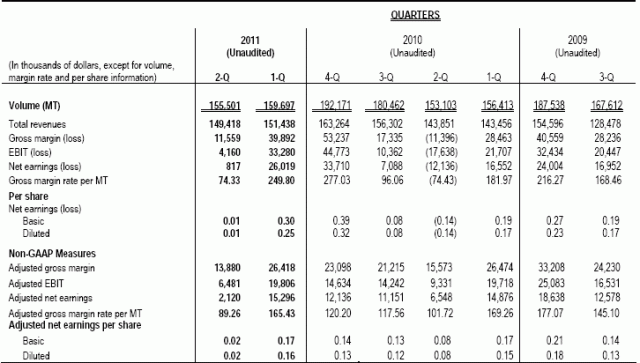I notice that a couple weeks ago Susan Brunner did an analysis of Rogers Sugar (TSX: RSI) (Part 1, Part 2). I generally like reading what Susan writes simply because she is very rigorous and quantitative. I am pretty sure that she does some more digging “underneath the hood” in the companies she profiles.
In the event of Rogers Sugar, I have been an investor in units since 2007 when it was still an income trust. I added significantly to my position during the 2008-2009 economic crisis. Although I have trimmed my position somewhat early this year, RSI is still a significant holding in my portfolio and I do not anticipate this changing unless if there is appreciation in the share value from current prices. The company is currently trading slightly above the upper end of my fair value range.
There are a few salient details which looking at the balance sheet and income statement will not bring up in a cursory analysis. This requires some knowledge about their business model. The company imports raw sugar cane (typically from Brazil) and also produces its own sugar beets (in Alberta) which is manufactured into sugar in its Taber, Alberta facility. Sugar cane is manufactured into sugar in Vancouver and Montreal.
The company makes extensive use of hedging to shelter volatility in cost inputs, particularly raw sugar and natural gas. As a result, due to GAAP accounting practices (and IFRS, which makes statements even more difficult to read) income streams are very volatile as contract values rise and fall. This makes quarterly income figures almost meaningless to compare from quarter to quarter and has little to do with the economic performance of the company. As a result, management provides in the MD&A documents an “adjusted gross margin” figure which is much more comparable from quarter to quarter. An example of the most recent quarter is as follows:
Q2-2011 was not very good, but volume has been relatively steady from 2010. The reason for the lackluster performance is because management has had a difficult to managing the volatility of sugar prices (see below):
Overall performance has also been hampered retrospectively from its full potential by management hedging natural gas pricing in an environment where spot pricing has been significantly cheaper than pricing a year or two out.
The company is in a duopoly situation with another major competitor in central Canada, and one other minor competitor. There is no real competition in the western half of the country. This, combined with adequate protection against international sugar trade (duties for US sugar imports make US competition prohibitively expensive) make Rogers Sugar economically very stable to invest in. There are signs of erosion from free trade agreements in Latin American countries and possibly the European Union, but so far this has not materialized and such threats have been present for a very long time. Despite its economically sheltered position, margins are relatively slim – 2010’s fiscal year had a 7% after-tax profit margin with the assumption that the income was fully taxable (the income trust structure sheltered most of the taxation until the end of 2010, but the statements have retrospective treatment of income tax provisions for comparability).
Finally, the company has $78M of 5.9% convertible debentures outstanding (TSX: RSI.DB.B) that mature on June 29, 2013. They are convertible into shares at $5.10, or about 15.3 million shares. The company has the right to call them at par value at any time (with 30 days notice). While the company should have no problem refinancing the debt, the overhang will likely serve as a drag on further share price appreciation. For the company, it also brings up a cost of financing issue since the interest bite on the debentures is $4.6 million per year pre-tax, while if converted the shares will pay an after-tax dividend of $5.2 million (and at a 25% stauatory tax rate, that translates into $6.9 million).
As sugar prices have continued to remain high, if the company is able to harvest its sugar beet crop in sufficient quantity, there would be a boost to gross margins and this is likely somewhat reflected in the existing stock price. It is likely that while there is some expectation of this already baked into the price, it is probably not priced in fully yet. If you have read this far, this is a predictive comment and actionable information if you care to speculate.
Management is very experienced in the industry and the key/controlling shareholder (Belkorp Industries, run by Stuart Belkin) owns a 12% stake in the common shares (but has the right to nominate a majority slate of directors in the operating company) and there is sufficient alignment of interests with non-controlling shareholders. Management compensation is fair, aligned to performance, and dilution has been kept to a minimum. I am surprised that the company hasn’t been taken private in a leveraged buyout when unit prices were lower, but at present prices this is not likely to happen.
While the company should have no problem paying out their cash dividend, given the nature of the industry, one would not want to hold onto Rogers Sugar if they are expecting a double in the price of their shares. Hence, Rogers Sugar is not a growth company, but rather a very stable income producer held in a non-registered account.


